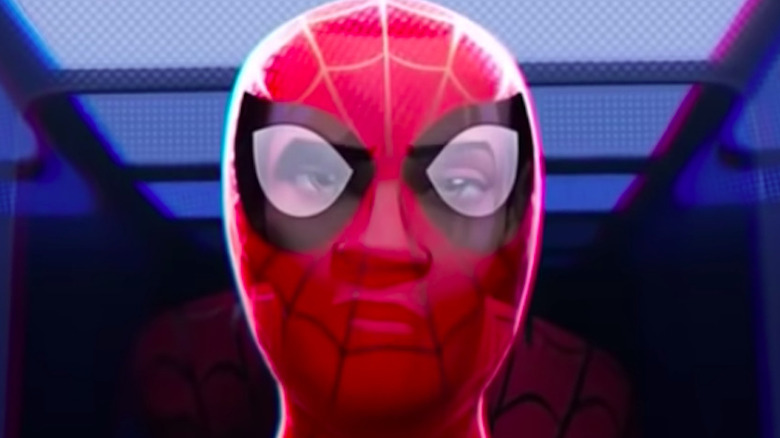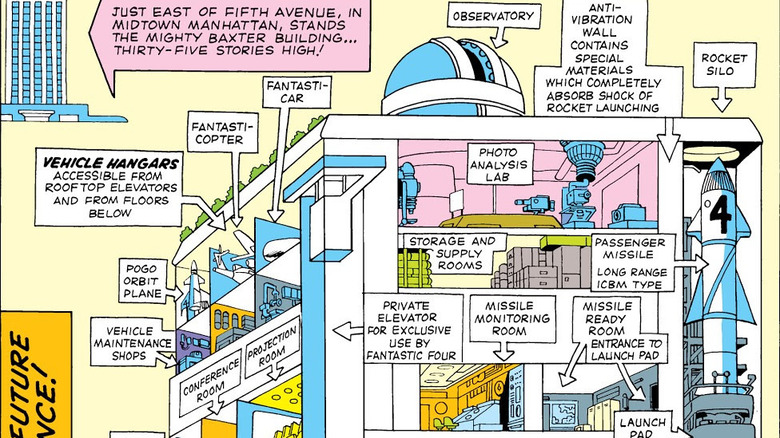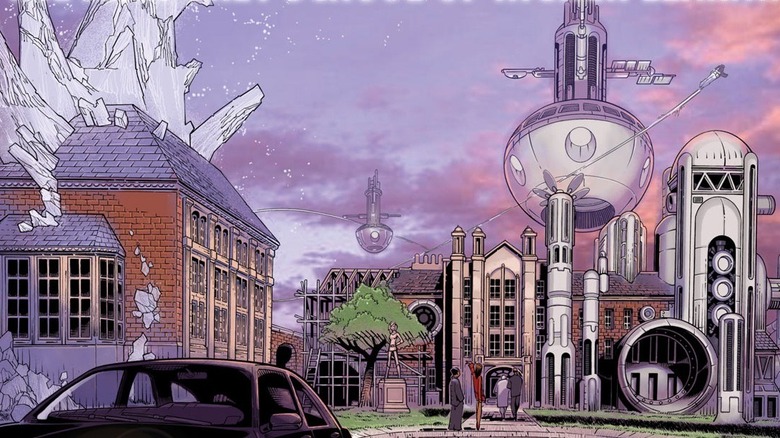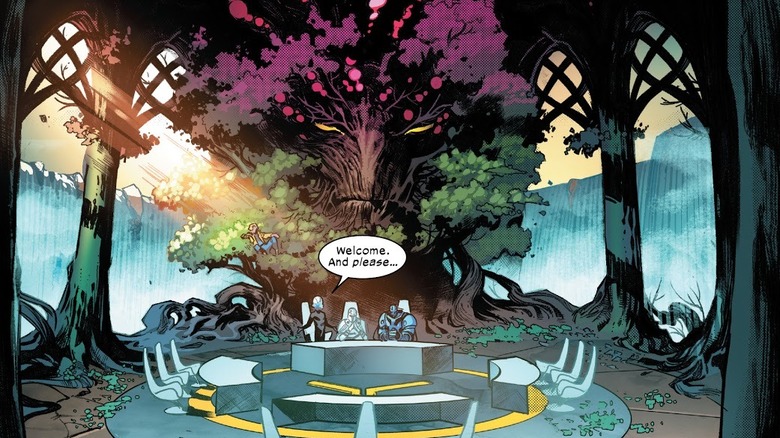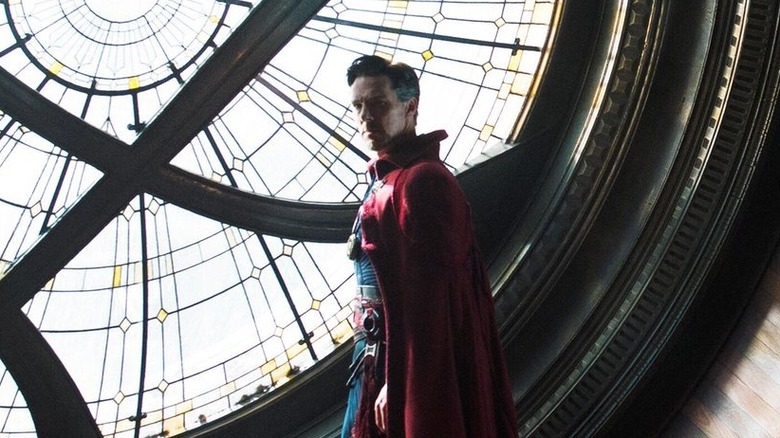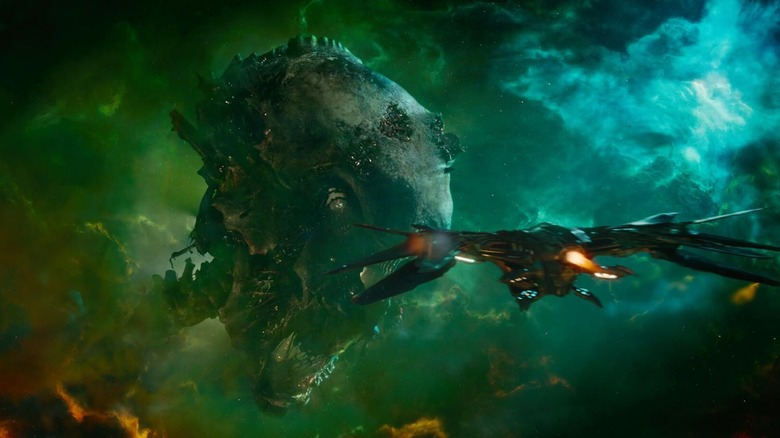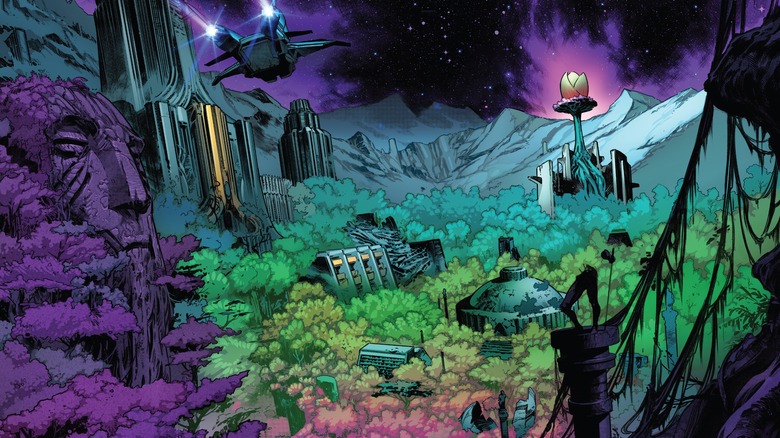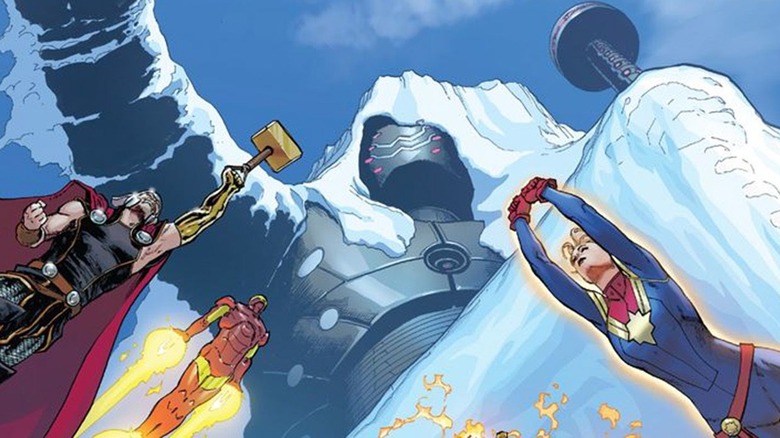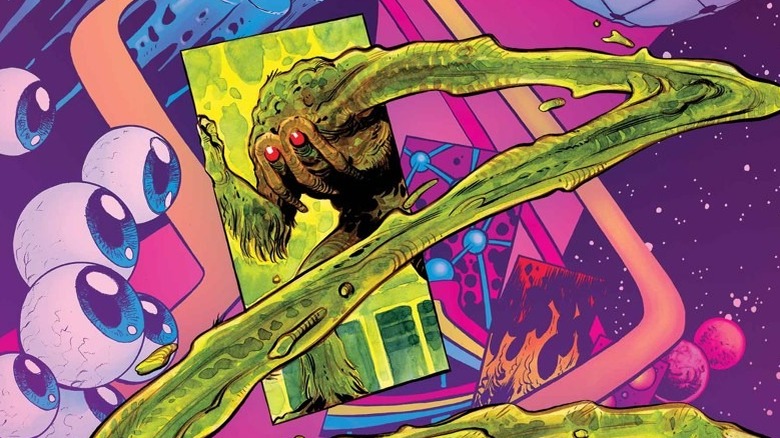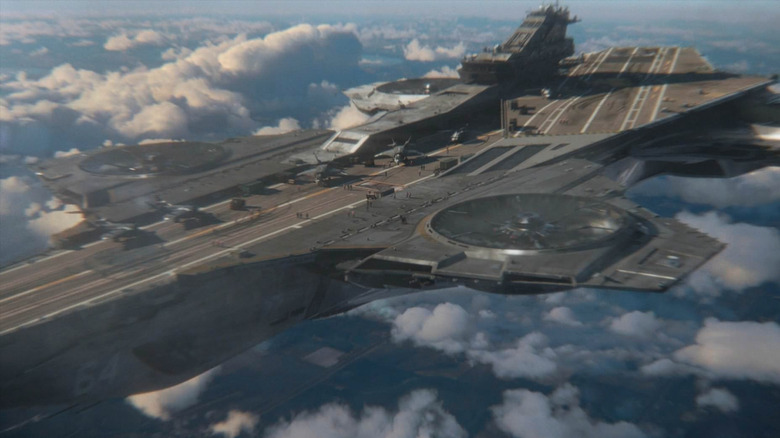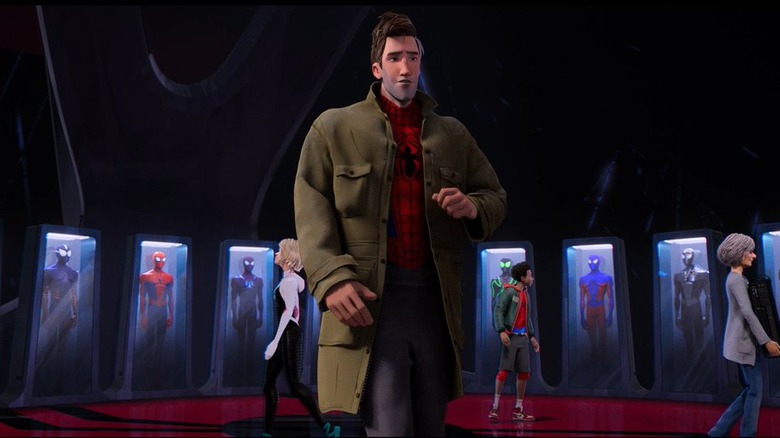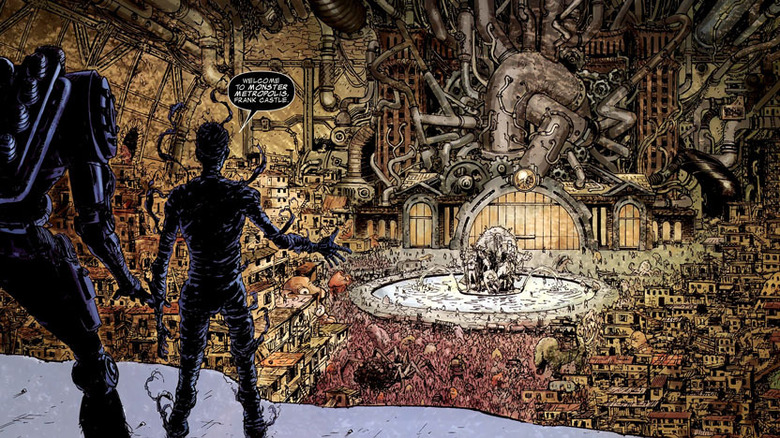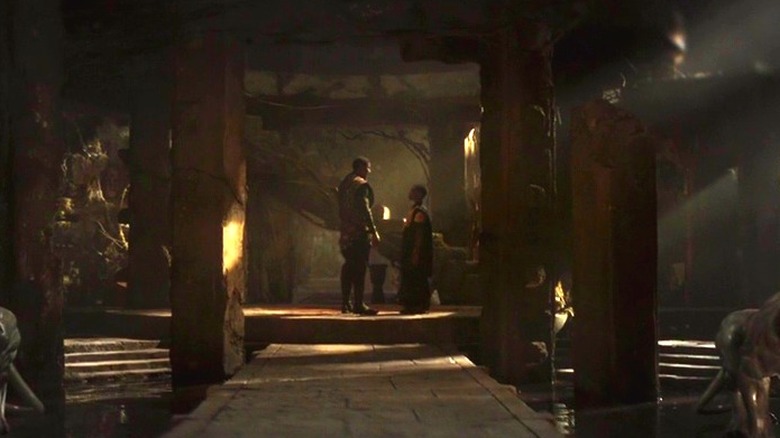The Coolest Superhero Hideouts In Marvel History
Month in and month out, Marvel Comics publishes new tales featuring Earth's greatest heroes. But where do they go in between adventures? Some of them just chill out under their secret identities in the same kinds of homes as everyone else. But Marvel's larger-than-life world means many of the heroes need to be larger than life even in their downtime. This means the heroes require home bases with powerful tech to continue their fight against evil and impenetrable defenses just in case the bad guys follow them home — not to mention collections of strange artifacts from past adventures and other dimensions.
They may be hidden on an ordinary street or might attract attention from miles away. They may showcase the latest space-age tech or could be older than the Earth itself. They may be in the middle of New York City or on the edge of the known universe. But no matter what, every hero needs a hideout, and here's the coolest ones the Marvel Universe has to offer.
The Baxter Building
The Marvel Universe began in 1961 with the debut of the Fantastic Four, and their home base laid the template for everything to follow. Marvel's First Family reconstructed an entire Manhattan skyscraper to suit their needs and moved in beginning in "Fantastic Four" #3. It has everything a team of interdimensional explorers could want: a portal to the mysterious Negative Zone; a museum of the heroes' adventures; storerooms full of alien weapons and other souvenirs; a robotic receptionist; launchpads for rockets and whatever other strange vehicles Dr. Reed Richards whips up; and a cavernous lab for his many wild experiments.
Beginning with "Fantastic Four" #567, writer Jonathan Hickman made the Baxter Building even wilder by turning it into the home of the Future Foundation, Reed's organization of gifted young people from under the sea, under the earth, and everywhere else you could think of. When most of the Foundation disappeared into the multiverse in "Secret Wars" (2015) and Spider-Man's "old Parker luck" gave him enough of a break to build his own tech corporation, he made the Baxter Building his own home base beginning in "Amazing Spider-Man" #3 (2015).
Xavier's School for Gifted Youngsters
As time went on, the X-Men replaced the Fantastic Four as Marvel's number one superteam, and they needed a home base of their own. Enter Charles Xavier's School for Gifted Youngsters, an apparently ordinary prep school whose students are much more gifted than the name lets on. It soon got all the goodies and gadgets a superhero hideout needs. Instead of a school bus, they have a Lockheed Blackbird jet in an underground hangar. Instead of a gym, they have the Danger Room, a high-tech training area filled with robotic tackle dummies to train against, until Xavier upgraded it with alien technology in "New Mutants" #1 (1983) to create a total virtual reality environment. Artist Frank Quitely gave the school an upgrade in "New X-Men" #114 (2001) with a new design that forms an "X" from above.
Writer Jason Aaron and artist Chris Bachalo gave the school an even bigger upgrade in "Wolverine and the X-Men" #1 (2011). Returning from a few years on an island off the West Coast, Wolverine reopens the academy as the Jean Grey School, building space-age additions in and above the centuries-old mansion. Thanks to a teleporter accident, it's also infested with little blue goblins called "Bamfs." And thanks to their enemies in the Hellfire Club, the X-Men's lawn is alive, replaced with a clone of Krakoa, the first bad guy Wolverine fought with the X-Men. Fortunately, Krakoa turns out to be a pretty good guy after all and even keeps the school financially liquid by growing diamond-bearing trees.
Krakoa
In "House of X," Jonathan Hickman moves the X-Men to the original Krakoa, now a sovereign mutant nation-state. Xavier and his former student Cypher cultivate the living island and find it can grow exotic plants named the Flowers of Krakoa. These include cures for deadly diseases and flowers that grow into self-sustaining habitats, connected to Krakoa's consciousness or portals to anywhere in the world. An enormous tree called the Arbor Magna serves as the Hatchery, where a team of mutants can make perfect recreations of any dead mutant, meaning dangerous missions aren't really an issue for the X-Men anymore. For less deadly injuries, "X-Force" #1 (2019) introduced the Healing Gardens, a lush, open-air hospital. To control the trade of the Flowers, Krakoa set up the Hellfire Trading Company, based out of the White Castle, Red Keep, and Blackstone in Hellfire Bay. Prisoners go to "No-places," habitats cut off from Krakoa's consciousness.
Krakoa has other habitats around the world, including one that expands the Danger Room to take up a whole island. And "Powers of X" #4 revealed Krakoa is much older than his inhabitants, and that thousands of years ago it had been part of the island Okkara until a mysterious enemy split it in two and sent its other half, Arakko, into a dimension of monsters.
The Sanctum Sanctorum
Doctor Strange has everything he needs to protect the multiverse right at home. Stan Lee nailed it down to a real location on Bleecker Street in New York City's Greenwich Village, but the inside is nothing like anything you could find in reality. That abstract design Steve Ditko created for the big bay window is striking, but that's almost normal compared to what's behind it. For one thing, the building is bigger on the inside. For another, it has a room full of the world's most powerful magical artifacts. And Strange isn't the only hero to call the Sanctum home: Beginning in "Civil War," a team of Avengers hid out there while the government hunted them down for refusing to register.
After overhauling the X-Men's hideout, comics writer Jason Aaron brought his magic touch to the Sanctum when he took over "Doctor Strange" in 2015. We learn that if you open the wrong door, you might wind up in another dimension, and that the stairways defy gravity, M.C. Escher-style. Even the fridge is full of monsters, which is why Strange's assistant Wong shut it up with big metal chains. Down in the basement is Mister Misery, the accumulated cost of all the Sorcerer Supreme's spells. Good luck getting inside to see it, though — the "Marvel Legacy" one-shot reveals Strange's security system includes a man-eating hedge. Aaron also gave Strange a second hideout in the Bar With No Doors, where he hobnobs with the Marvel Universe's greatest magicians, including the Scarlet Witch, Shaman and Doctor Voodoo.
Knowhere
Far, far away from these other places, you'll find Knowhere, the satellite the Guardians of Galaxy called home beginning with the first issue of the 2008 series. Built inside the head of a dead Celestial at the edge of the known universe, Knowhere became a hub for scientists looking to observe the limits of possible knowledge. Security responsibilities go to Cosmo, a dog launched by the Soviet space program, who learned to talk and gained other psychic abilities thanks to cosmic radiation. Writers Donny Cates and Ryan Stegman revealed the station's origins in "Venom" #4 (2018), explaining that it was a Celestial head cut off by the void god Knull. He uses the severed head as a forge to make All-Black, the Necrosword, and Cates confirmed on Twitter that this was the same Celestial head that eventually became Knowhere.
Knowhere also appeared in the "Guardians of the Galaxy" movie, this time as a mining colony extracting the rare elements the Celestial contained. The Guardians never use it as a base, but it does serve as one for the Collector, who owns the mining operation along with his cache of Infinity Stones and other rare artifacts. Cosmo's still there, though, at least in the post-credits scene.
The Blue Area of the Moon
The Fantastic Four began life in a failed space mission, and in "Fantastic Four" #13, Stan Lee and Jack Kirby finally took them to the moon, seven years before Neil Armstrong landed there in real life. Unlike real life, they discovered a mysterious "blue area" with breathable air and the ruins of an ancient city. This is the home of the Watcher, one of a race of powerful cosmic beings who have sworn never to use their power to interfere with other planets, but only to watch.
Later, the Blue Area also became home to the Inhumans in "FF" #240, when Earth's pollution became too much for them to take and they flew their entire home city of Attilan to the moon. In #577, Hickman made the Blue Area home to the Council of Universal Inhumans, representatives from other planets where the alien Kree Empire had performed the same genetic experiments that created earth's Inhumans, including the horselike Kymelians and the monstrous Dire Wraiths. The Inhumans moved back to Earth in 2014's "Inhuman" #2, leaving the Watcher without neighbors for a while. But then Hickman returned to the concept in "House of X" #1, where he introduced Summer House, a Krakoan habitat and the home base for Cyclops and the rest of the extended Summers family.
Avengers Mountain
Marvel's mightiest heroes have had their share of home bases over the years, but most of them have been disappointingly mundane — a mansion, a skyscraper, and so on. They finally got a hideout worthy of them from Jason Aaron and David Marquez in "Avengers" #8 (2018). The new volume opened with the Avengers discovering the billions-of-years-old body of the Progenitor, a Celestial who landed on Earth as it was dying of a deadly infection. An army of other infected Celestials raised up the corpse from its resting place at the bottom of the Arctic Ocean to fight the Avengers. To thank the Avengers for defeating the Dark Celestials, saving both the Earth and the Celestials, the cosmic beings let them keep the body.
It has turned out to be a surprisingly practical facility. Black Panther called in "the finest architects from Wakanda," who restarted the Celestial's heart for use as a global teleport system, rigged an elevator in the mountain's spine and built hangars for each of the Avengers' vehicles in its fingers. "Avengers" #45 reveals the Mountain also has a jogging track along the femoral artery, a weight room in the bicep, and a Library of Intergalactic Law in the lungs, while the appendix was turned into an indoor garden called the Eden Room. But it's not all business — in "Avengers" #21, the team relaxes after the War of the Realms in an apparently natural hot spring somewhere in the lower levels, with huge windows offering views of the local sea life.
The Nexus of All Realities
In "Savage Tales" #1 (1971), the Marvel Universe got its own version of a classic swamp monster from creators Roy Thomas, Gerry Conway, and Gray Morrow. His name was the Man-Thing, formerly biochemist Ted Sallis, whose attempt at a super-soldier formula and a trip to the bottom of the Florida Everglades turned him into a half-conscious pile of sludge.
Every swamp monster needs a swamp, and Man-Thing's home outside Citrusville, Florida seemed like a pretty ordinary one for his first few years of existence. Writer Steve Gerber started dropping hints the swamp was something more in "Adventure into Fear" #11, where Man-Thing fights a demon who recognizes the swamp as a "nexus" that heals Man-Thing from his injuries. In #13, we learn it's even more significant than that: It's actually the Nexus of All Realities, a hub connecting every point in the multiverse that a local cult wants control of.
This would give Man-Thing plenty of interdimensional nonsense to deal with, including depositing an unwilling visitor from a world of talking animals into the swamp in #19. His name was Howard the Duck, and he'd end up becoming Gerber's most enduring creation, getting a spinoff series, his own movie, and multiple appearances in the current Marvel Cinematic Universe. As for the Nexus, it ended up becoming an integral part of the Man-Thing's character, as he got upgraded from local muck-monster to the mystic location's guardian.
The SHIELD Helicarrier
Jack Kirby came up with more wild ideas in his career than most of us could in 12 lifetimes, and if there was one thing he loved dreaming up, it was huge, outlandish vehicles. None of them were huger, more outlandish, or more iconic than the S.H.I.E.L.D. Helicarrier, which is exactly what it says: a flying, full-sized aircraft carrier that first appeared in "Strange Tales" #135 (1951). That story was former war hero Nick Fury's introduction to the world of the Marvel Universe's foremost secret agency. As S.H.I.E.L.D. became more involved in the superhero side of the Marvel Universe, meetings onboard the Helicarrier became a familiar sight. We'd eventually learn S.H.I.E.L.D. has a whole fleet of the things, but whichever one the heroes are onboard, it's the kind of flying clubhouse every kid dreams of.
We got to see those dreams more vividly than ever in the 2012 movie "The Avengers," which brought the Helicarrier to the big screen. This version looks more like a real aircraft carrier, and Captain America thinks that's what it is until it lifts off. The Helicarrier becomes home base for the new team — at least until Loki attacks it.
The Spider-Cave
A big part of the appeal of Spider-Man is that he's a regular guy when he's not wearing the tights, barely scraping by with enough money to pay for the kind of crummy apartment most of his readers can recognize. That doesn't leave much room for an elaborate secret base, but in "Spider-Man: Into the Spider-Verse," we see that the older Peter Parker of Miles Morales' universe has managed to build himself an impressive secret base underneath a garden shed in his Aunt May's Forest Hills home.
An elevator leads the other Spider-Men into a sleek space-age bunker, with platforms for Peter's gym, his Spider-Mobile, and his Spider-Plane, with glistening spider webs everywhere to set the mood. The ground floor hosts Peter's lab, with a gallery of his spare Spider-suits, a supercomputer, and a literal web diagramming the Kingpin's crime empire. This is Spider-Man's own version of the Batcave, with Aunt May taking on Alfred's mission-control duties, and if anything, it's even cooler than the caverns beneath Wayne Manor.
The Monster Metropolis
Even before the Marvel Universe as we know it existed, it was full of monsters, thanks to the library of horror comics published by Marvel forerunner Atlas Comics. All those monsters needed someplace to go where they wouldn't get hassled by angry mobs of villagers, and the Punisher discovered it in Rick Remender and Stuart Moore's "Punisher" #11 (2009). After getting torn to ribbons by Wolverine's son Daken, Frank Castle woke up in the Monster Metropolis to discover he'd been resurrected as a Frankenstein-ish monster by Morbius. He found out the vampire scientist has taken him to a city of werewolves, mummies, mole people, and other weird critters beneath the streets of New York, and in #12, he discovered its hub in a Gothic building with one wall taken up by a portrait of Marvel's greatest monster heroes and another by a collection of exotic weapons.
Frank would eventually get de-Frankensteined after defending the city from the psychotic monster hunter Helsgaard, but the Monster Metropolis returned as the home base for the Legion of Monsters in their 2011 series, and Deadpool would make it home after marrying the monster princess Shiklah in "Deadpool" #27 (2012). But that ended about as poorly as everything does for him.
The Necropolis of Wakanda
As he wrapped up his run on "Fantastic Four," Jonathan Hickman started laying the groundwork for his next assignment on "New Avengers" (2012). But there was one loose end to take care of first: T'Challa, the original Black Panther, was a major part of his Avengers plans, but at the time, he'd lost the title to his sister Shuri. Hickman hit on a perfect solution in "Fantastic Four" #607, where T'Challa and Reed Richards follow an army of undead attackers into the ancient Necropolis, the Wakandan city of the dead where past Black Panthers are buried. T'Challa meets with Bast, the Panther Goddess who offers him a compromise: Shuri will remain the queen of the living Wakandans, and T'Challa will become the king of the dead. Later, in "New Avengers," the Necropolis becomes home base for the Illuminati, a covert team of heroes working in secret to protect the Earth's destruction by "incursions" from parallel universes. The Necropolis then becomes a prison for their enemies Terrax, Black Swan, and, eventually, Thanos.
The Necropolis takes on even more importance in the Marvel Cinematic Universe. In the "Black Panther" movie, the City of the Dead is where the royal family grows the heart-shaped herbs that give the Panthers their powers, and acts as the gateway to the Ancestral Plane, where the living can meet the dead.
